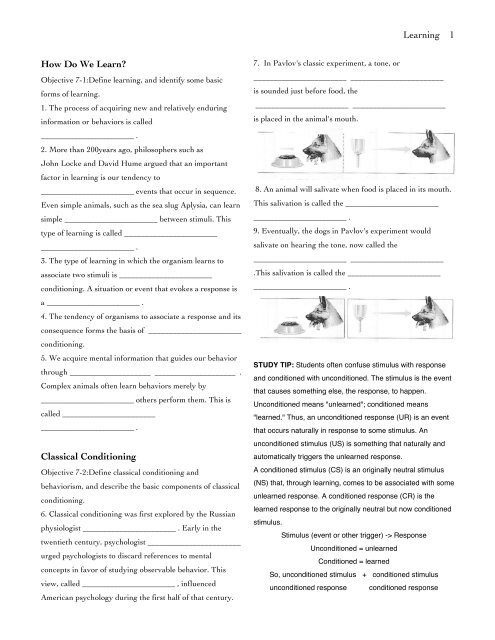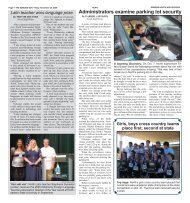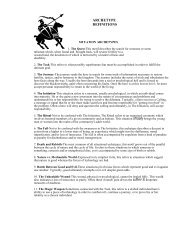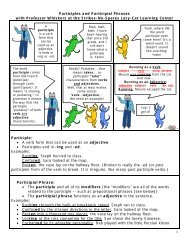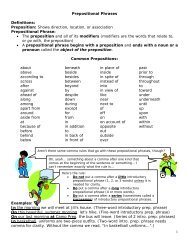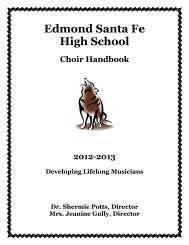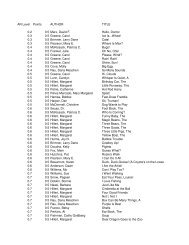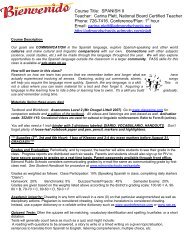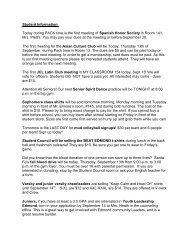SG-Ch 7 Learning.pdf - Edmond Public Schools
SG-Ch 7 Learning.pdf - Edmond Public Schools
SG-Ch 7 Learning.pdf - Edmond Public Schools
Create successful ePaper yourself
Turn your PDF publications into a flip-book with our unique Google optimized e-Paper software.
<strong>Learning</strong> 1<br />
How Do We Learn?<br />
Objective 7-1:Define learning, and identify some basic<br />
forms of learning.<br />
1. The process of acquiring new and relatively enduring<br />
information or behaviors is called<br />
_______________________ .<br />
2. More than 200years ago, philosophers such as<br />
John Locke and David Hume argued that an important<br />
factor in learning is our tendency to<br />
_______________________ events that occur in sequence.<br />
Even simple animals, such as the sea slug Aplysia, can learn<br />
simple _______________________ between stimuli. This<br />
type of learning is called _______________________<br />
_______________________ .<br />
3. The type of learning in which the organism learns to<br />
associate two stimuli is _______________________<br />
conditioning. A situation or event that evokes a response is<br />
a _______________________ .<br />
4. The tendency of organisms to associate a response and its<br />
consequence forms the basis of _______________________<br />
conditioning.<br />
5. We acquire mental information that guides our behavior<br />
through ____________________ ____________________ .<br />
Complex animals often learn behaviors merely by<br />
_______________________ others perform them. This is<br />
called _______________________<br />
_______________________ .<br />
Classical Conditioning<br />
Objective 7-2:Define classical conditioning and<br />
behaviorism, and describe the basic components of classical<br />
conditioning.<br />
6. Classical conditioning was first explored by the Russian<br />
physiologist _______________________ . Early in the<br />
twentieth century, psychologist _______________________<br />
urged psychologists to discard references to mental<br />
concepts in favor of studying observable behavior. This<br />
view, called _______________________ , influenced<br />
American psychology during the first half of that century.<br />
7. In Pavlov's classic experiment, a tone, or<br />
_______________________ _______________________<br />
is sounded just before food, the<br />
_______________________ _______________________<br />
is placed in the animal's mouth.<br />
8. An animal will salivate when food is placed in its mouth.<br />
This salivation is called the _______________________<br />
_______________________ .<br />
9. Eventually, the dogs in Pavlov's experiment would<br />
salivate on hearing the tone, now called the<br />
_______________________ _______________________<br />
.This salivation is called the _______________________<br />
_______________________ .<br />
STUDY TIP: Students often confuse stimulus with response<br />
and conditioned with unconditioned. The stimulus is the event<br />
that causes something else, the response, to happen.<br />
Unconditioned means "unlearned"; conditioned means<br />
"learned." Thus, an unconditioned response (UR) is an event<br />
that occurs naturally in response to some stimulus. An<br />
unconditioned stimulus (US) is something that naturally and<br />
automatically triggers the unlearned response.<br />
A conditioned stimulus (CS) is an originally neutral stimulus<br />
(NS) that, through learning, comes to be associated with some<br />
unlearned response. A conditioned response (CR) is the<br />
learned response to the originally neutral but now conditioned<br />
stimulus.<br />
Stimulus (event or other trigger) -> Response<br />
Unconditioned = unlearned<br />
Conditioned = learned<br />
So, unconditioned stimulus + conditioned stimulus<br />
unconditioned response conditioned response
2<br />
<strong>Learning</strong><br />
at<br />
its<br />
_<br />
rs<br />
APPLICATIONS:<br />
Classical conditioning is all around us. It is especially common<br />
in the realm of emotional behavior. Test your understanding of<br />
the basic elements of classical conditioning in the following<br />
example. Then, consider whether there are emotions of your<br />
own that might have developed as the product of classical<br />
conditioning.<br />
As a child, you were playing in the yard one day when a<br />
neighbor's cat wandered over. Your mother (who has a<br />
terrible fear of animals) screamed and snatched you into her<br />
arms. Her behavior caused you to cry. You now have a fear of<br />
As a child, you were playing in the yard one day<br />
when cats. a neighbor's cat wandered over. Your mother<br />
(who 10. The has NS, a then terrible CS is fear ______________________________<br />
of animals) screamed and<br />
snatched you into her arms. Her behavior caused you<br />
to11. cry. The You US is now ______________________________________<br />
have a fear of cats.<br />
10.<br />
12.<br />
The<br />
The CR<br />
NS,<br />
is<br />
then<br />
______________________________________<br />
CS is<br />
13. The UR is ______________________________________<br />
-----------<br />
11. The US is<br />
---------------<br />
14. You always rattle the box of dog biscuits before giving<br />
12. The CR is<br />
---------------<br />
your dog a treat. As you do so, your dog salivates. At first,<br />
13. The UR is<br />
rattling the ---------------<br />
box is a _ which eventually becomes a __ .<br />
14. Your always dog's salivation rattle the is a box . _ of dog biscuits before<br />
givinga. your NS; CS; dogCR<br />
a treat. As you do so, your dog<br />
salivates. At first, rattling the box is a _<br />
b. CS; NS; UR<br />
which eventually becomes a __<br />
. Your<br />
dog'sc. salivation NS; US; CR is a .<br />
_<br />
a. NS; d. US; CS; NS; CRUR<br />
b. CS; NS; UR<br />
c. NS; US; CR<br />
d. US; NS; UR<br />
Objective 7-3: Summarize the processes of acquisition,<br />
Objective 7-3:Summarize the processes of acquisition,<br />
extinction, extinction, spontaneous spontaneous recovery, recovery, generalization, generalization,<br />
and<br />
and discrimination. discrimination.<br />
Use the following graph as a reference for the<br />
Use answers the following to 15(a), 19(b),and graph as 20(c). a reference for the<br />
answers to 15(a), 19(b),and 20(c).<br />
Strong TI a. CS+ us b. CSalone c.<br />
Strength<br />
ofCR<br />
Weak I , ~ n_ .. __<br />
::::::000..""<br />
Time<br />
15. The initial learning of a conditioned response is called<br />
15. The initial learning of a conditioned response is<br />
(a) _______________________ . For many conditioning<br />
called (a)<br />
. For many conditioning<br />
situations, the optimal interval between a<br />
situations, the optimal interval between a neutral stimulus<br />
and the US is _______________________<br />
neutral stimulus and the US is<br />
_______________________ .<br />
16. When the US is presented prior to a neutral stimulus,<br />
conditioning (does/does not) occur.<br />
17. Sexual conditioning studies with quail demonstrate that<br />
classical conditioning is highly adaptive because it helps<br />
animals _______________________ and<br />
_______________________ .<br />
18. The procedure in which an established conditioned<br />
stimulus is paired with a different<br />
_______________________ stimulus, thereby establishing<br />
the latter as a _______________________ stimulus, is called<br />
_______________________-_______________________<br />
_______________________ ,<br />
19. If a CS is repeatedly presented without the US,<br />
(b) _______________________ soon occurs; that is, the<br />
CR diminishes.<br />
20. Following a pause, however, the CR reappears in<br />
response to the CS; this phenomenon is called<br />
(c) _______________________<br />
_______________________ .<br />
21. Subjects often respond to a similar stimulus as they<br />
would to the original CS. This phenomenon is called<br />
_______________________ .<br />
22. Humans and other animals can also be trained not to<br />
respond to _______________________ stimuli. This<br />
learned ability is called _______________________<br />
23. Being able to recognize differences among stimuli has<br />
_______________________ value because it lets us limit<br />
our learned responses to appropriate stimuli.<br />
STUDY TIP: Some students find the terms discrimination and<br />
generalization confusing because of their negative social<br />
connotations. In the context of classical conditioning,<br />
discrimination is a healthy sign that the subject of conditioning<br />
has learned the difference between two stimuli, much as a<br />
"discriminating coffee lover" can taste subtle variations<br />
between two coffee blends. Generalization is apparent when<br />
discrimination does not occur.<br />
16. When the US is presented prior to a neutral stim-
<strong>Learning</strong> 3<br />
APPLICATION:<br />
Bill had an American-made car that was in the shop more<br />
than it was out. Since then he will not even consider owning<br />
an American-made car.<br />
24. Bill's attitude is an example of<br />
_______________________ . Bill's friend Andy also had<br />
an American-made car with similar problems. Deciding<br />
that it was just that brand, Andy decided to try another<br />
brand. Rather than bunch all American-made cars<br />
together, he was a _______________________ buyer of<br />
cars.<br />
Objective 7-4:Explain why Pavlov's work remains so<br />
important, and describe some applications of his work to<br />
human health and well-being.<br />
25. Classical conditioning is one way that virtually all<br />
organisms learn to _______________________ to their<br />
environment.<br />
26. Another aspect of Pavlov's legacy is that he showed<br />
how a process such as learning could be studied<br />
_______________________ .<br />
Explain why the study of classical conditioning is<br />
important.<br />
27. Through classical conditioning, former drug users often<br />
feel a _______________________ when they are in the<br />
_______________________ associated with previous highs.<br />
28. Research studies demonstrate that the body's immune<br />
system (can/cannot) be classically conditioned.<br />
Describe the Watson and Rayner experiment.<br />
Objective 7-5: Describe how operant behavior is<br />
reinforced and shaped.<br />
29. B. F. Skinner used Thorndike's<br />
_______________________ _______________________<br />
_______________________ as a starting point in<br />
developing a behavioral technology. This principle states<br />
that _______________________ behavior is likely to<br />
_______________________ .<br />
30. In operant conditioning, organisms associate their own<br />
actions with _______________________ . Actions followed<br />
by _______________________ increase; actions followed<br />
by _______________________ decrease.<br />
31. Skinner designed an apparatus, called the<br />
_______________________ _______________________ to<br />
investigate learning in<br />
animals. This design<br />
creates a stage on<br />
which organisms act<br />
out Skinner's concept<br />
of ________________<br />
any event that<br />
increases the<br />
frequency of a preceding response.<br />
32. The procedure in which a person teaches an animal to<br />
perform an intricate behavior by building up to it in small<br />
steps is called _______________________ . This method<br />
involves reinforcing successive of the desired behavior.<br />
33. In experiments to determine what an animal can<br />
perceive, researchers have found that animals are capable of<br />
forming and _______________________ between stimuli.<br />
Similar experiments have been conducted with babies, who<br />
also can't verbalize their responses.<br />
34. A situation, event, or signal that a certain response will<br />
be reinforced is a _______________________<br />
_______________________ .
4<br />
<strong>Learning</strong><br />
APPLICATION:<br />
35. Which of the following is an example of shaping?<br />
a. A dog learns to salivate at the sight of a box of dog<br />
biscuits.<br />
b. A new driver learns to stop at an intersection when the<br />
light changes to red.<br />
c. A parrot is rewarded first for making any sound, then<br />
for making a sound similar to "Laura," and then for<br />
"speaking" its owner's name.<br />
Objective 7-6: Discuss the differences between positive and<br />
negative reinforcement, and identify the basic types of<br />
reinforcers.<br />
36. A stimulus that strengthens a response by presenting a<br />
typically pleasurable stimulus after a response is a<br />
_______________________ _______________________ .<br />
37. A stimulus that strengthens a response by reducing or<br />
removing an aversive (unpleasant) stimulus is a<br />
_______________________ _______________________ .<br />
38. Reinforcers, such as food and shock, that are related to<br />
basic needs and therefore do not rely on learning are called<br />
_______________________ _______________________ .<br />
39. Reinforcers that must be conditioned and therefore<br />
derive their power through association are called<br />
_______________________ _______________________ .<br />
40. <strong>Ch</strong>ildren who are able to delay gratification tend to<br />
become (more/less) socially competent and high achieving<br />
as they mature.<br />
41. Immediate reinforcement (is/is not) more effective than<br />
its alternative, _______________________ reinforcement.<br />
This explains in part the difficulty that<br />
_______________________ users have in quitting their<br />
habits, as well as the tendency of some teens to engage in<br />
risky, _______________________<br />
_______________________ .<br />
STUDY TIP: Some students have a problem differentiating<br />
positive and negative reinforcers because they naturally think<br />
"positive" indicates a "good," or desirable, outcome, while<br />
"negative" connotes a "bad," or undesirable, outcome.<br />
Remember that from the organism's point of view,<br />
reinforcement is always a desirable outcome. You may find it<br />
useful to think of a photography analogy. A "negative" is a<br />
reverse image in which the "positive" photographic image is<br />
not present. So too, negative reinforcement involves taking<br />
away an event-in this case, one that is undesirable.<br />
Objective 7-7: Explain how the different reinforcement<br />
schedules affect behavior.<br />
42. A _______________________<br />
_______________________ is a pattern specifying how<br />
often a _______________________<br />
_______________________ is reinforced.<br />
43. The procedure involving reinforcement of each and<br />
every response is called _______________________<br />
_______________________ . Under these conditions,<br />
learning is (rapid/slow). When this type of reinforcement is<br />
discontinued, extinction is (rapid/ slow).<br />
44. The procedure in which responses are reinforced only<br />
part of the time is called _______________________<br />
reinforcement. Under these conditions, learning is generally<br />
(faster /slower) than it is with continuous reinforcement.<br />
Behavior reinforced in this manner is (very /not very)<br />
resistant to extinction.<br />
45. When behavior is reinforced after a set number of<br />
responses, a _______________________ -<br />
_______________________ schedule is in effect.<br />
46. Three-year-old Yusef knows that if he cries when he<br />
wants a treat, his mother will sometimes give in. When, as<br />
in this case, reinforcement occurs after an unpredictable<br />
number of responses, a _______________________ -<br />
_______________________ schedule is being used.<br />
47. Reinforcement of the first response after a set interval of<br />
time defines the _______________________ -<br />
_______________________ schedule. An example of this<br />
schedule is _______________________________________ .<br />
48. When the first response after varying amounts of time is<br />
reinforced, a _______________________ -<br />
_______________________ schedule is in effect.
<strong>Learning</strong> 5<br />
Describe the typical patterns of response under fixedinterval,<br />
fixed-ratio, variable-interval, and variable-ratio<br />
schedules of reinforcement.<br />
APPLICATlONS:<br />
49. You are expecting an important letter in the mail. As the<br />
regular delivery time approaches you glance more and<br />
more frequently out the window, searching for the letter<br />
carrier. Your behavior in this situation typifies that<br />
associated with which schedule of reinforcement?<br />
a. fixed-ratio c. fixed-interval<br />
b. variable-ratio d. variable-interval<br />
50. From a casino owner's viewpoint, which of the following<br />
jackpot-payout schedules would be the most desirable for<br />
reinforcing customer use of a slot machine?<br />
a. variable-ratio<br />
b. fixed-ratio<br />
c. variable-interval<br />
d. fixed-interval<br />
51. Lars, a shoe salesman, is paid every two weeks; whereas,<br />
Tom receives a commission for each pair of shoes he<br />
sells. Evidently, Lars is paid on a<br />
_______________________ schedule of reinforcement,<br />
and Tom on a _______________________ schedule of<br />
reinforcement.<br />
a. fixed-ratio; fixed-interval<br />
b. continuous; intermittent<br />
c. fixed-interval; fixed-ratio<br />
d. variable-interval; variable-ratio<br />
52. Jack finally takes out the garbage in order to get his father<br />
to stop pestering him. Jack's behavior is being influenced<br />
by _______________________<br />
_______________________ .<br />
53. Your instructor invites you to her home as part of a select<br />
group of students to discuss possible careers in<br />
psychology. The invitation is an example of a<br />
_______________________<br />
_______________________ .<br />
Objective 7-8: Discuss how punishment and negative<br />
reinforcement differ, and explain how punishment affects<br />
behavior.<br />
54. Negative reinforcement (increases / decreases) a<br />
response by _______________________ an aversive<br />
stimulus after that response. Punishment<br />
(increases/decreases) a response by<br />
_______________________ an aversive stimulus after that<br />
response.<br />
55. An aversive consequence that decreases the likelihood<br />
of the behavior that preceded it is called<br />
_______________________ . If an aversive stimulus is<br />
administered, it is called _______________________<br />
_______________________ . If a desirable stimulus is<br />
withdrawn, it is called _______________________<br />
_______________________ .<br />
56. Because punished behavior is merely<br />
_______________________ , it may reappear. Also,<br />
punishment teaches _______________________ , that<br />
behavior that is unacceptable in one context may be<br />
acceptable in another. Punishment can also lead to<br />
_______________________ and a sense of helplessness, as<br />
well as to the association of the aversive event with<br />
_______________________ _______________________.<br />
57. Punishment also often increases<br />
_______________________ and does not guide the<br />
individual toward more desirable behavior.<br />
STUDY TIP/APPLICATION: To avoid the natural tendency to<br />
confuse punishment and negative reinforcement, remember<br />
that positive reinforcement and negative reinforcement both<br />
lead to an increase in behavior, while punishment decreases<br />
behavior. In punishment, something bad occurs following an<br />
undesirable behavior; in negative reinforcement, something<br />
bad is removed. Complete the chart below of examples of<br />
punishment and negative reinforcement. The first example<br />
has been filled in for you.
6<br />
be acceptable in another. Punishment can also<br />
lead to<br />
and a sense of helplessness,<br />
as well as to the association of the aversive<br />
event with<br />
<strong>Learning</strong><br />
_<br />
In punishment, something bad occurs following an<br />
undesirable behavior; in negative reinforcement,<br />
something bad is removed. Complete the chart<br />
below of examples of punishment and negative reinforcement.<br />
The first example has been filled in for<br />
you.<br />
58. Which Is Taken Away, Is This Punishment or<br />
Behavior Consequence Something Good or Bad? Negative Reinforcement?<br />
Driving<br />
Lose driver's<br />
while intoxicated license Good Punishment<br />
a. Forgetting to give your<br />
roommate a phone<br />
message<br />
b. Putting on your coat<br />
so that you are<br />
no longer cold<br />
c. Getting a drink<br />
when you are thirsty<br />
d. Using your laptop<br />
until the battery dies<br />
e. Your brother nagging<br />
you until you help<br />
him with his homework<br />
Objective 7-9:Describe the the controversy over over Skinner's<br />
Skinner's views of human behavior, and identify<br />
views of human behavior, and identify some ways to apply<br />
some ways to apply operant conditioning principles<br />
operant at school, conditioning in sports, principles at work, and at school, at home. in sports, at work,<br />
and at home.<br />
59. Skinner's views were controversial because he<br />
59. Skinner's<br />
insisted<br />
views<br />
that<br />
were controversial because<br />
influences,<br />
he insisted<br />
that _______________________ rather than<br />
influences, _ rather than<br />
_______________________ and _______________________ _<br />
and _______________________ shape behavior. shape behavior.<br />
60. 60. Skinner Skinner also also advocated advocated the the use use of of<br />
_________ principles to influence people<br />
in ways that promote more desirable<br />
_______________________ principles to influence people<br />
in ways that promote more desirable<br />
_______________________ .<br />
61. Skinner's critics argued that he<br />
61. Skinner's ________ critics argued that people he by neglecting their<br />
_______________________ people by neglecting their<br />
personal _______________________ and by seeking to<br />
_______________________ their actions.<br />
62. The use of teaching machines and programmed<br />
textbooks was an early application of the operant<br />
conditioning procedure of _______________________ to<br />
education. Online systems, software that is<br />
_______________________ and<br />
_______________________-based learning are newer<br />
examples of this application of operant principles.<br />
Reinforcement principles can also be used to enhance<br />
_______________________ abilities by shaping successive<br />
approximations of new skills.<br />
63. In personal boosting productivity in the workplace, and by seeking positive to<br />
reinforcement _________ is (more/less) effective their actions. when applied to<br />
specific 62. The behaviors use of teaching than when machines given to and reward programmed general merit<br />
and when<br />
textbooks<br />
the desired<br />
was an<br />
performance<br />
early application<br />
is well defined<br />
of the operant<br />
and<br />
conditioning procedure of<br />
_<br />
_______________________ . For such behaviors,<br />
to education. Online<br />
systems,<br />
immediate reinforcement<br />
software that<br />
is<br />
is<br />
(more/no more) effective<br />
_<br />
than<br />
delayed andreinforcement.<br />
-based learning<br />
64. In are using newer operant examples conditioning of this to application change your of own operant<br />
behavior, principles. you would Reinforcement follow these principles four steps can also be<br />
used to enhance<br />
abilities by<br />
a. ______________________________________________<br />
shaping successive approximations of new skills.<br />
b. ______________________________________________<br />
63. In boosting productivity in the workplace, positive<br />
reinforcement is<br />
_<br />
c. ______________________________________________<br />
d. ______________________________________________<br />
(more/less) effective when applied to specific<br />
APPLICATIONS:<br />
65. The manager of a manufacturing plant wishes to use<br />
positive reinforcement to increase the productivity of<br />
workers. Which of the following procedures would<br />
probably be the most effective?<br />
a. Deserving employees are given a general merit<br />
bonus at the end of each fiscal year.<br />
b. A productivity goal that seems attainable, yet is<br />
unrealistic, is set for each employee.<br />
c. Employees are given immediate bonuses for<br />
specific behaviors related to productivity.<br />
d. Employees who fail to meet standards of<br />
productivity receive pay cuts.
ductivity of workers. Which of the following procedures<br />
would probably be the most effective?<br />
a. Deserving employees are given a general<br />
merit bonus at the end of each fiscal year.<br />
b. A productivity goal that seems attainable, yet<br />
is unrealistic, is set for each employee.<br />
c. Employees are given immediate bonuses for<br />
66. Reggie's specific mother behaviors tells him that related he can to watch productivity. TV after he<br />
cleans d. Employees his room. Evidently, who fail to Reggie's meet mother standards is attempting of productivity<br />
receive pay cuts.<br />
to use to increase room cleaning.<br />
66. Reggie's a. operant mother conditioning tells him that he can watch<br />
TV after he cleans his room. Evidently, Reggie's<br />
mother b. secondary is attempting reinforcement to use to<br />
increase c. positive room reinforcement cleaning.<br />
a. d. operant all of these conditioning procedures<br />
b. secondary reinforcement<br />
c. positive reinforcement<br />
d. all of these procedures<br />
Objective 7-10:Identify the characteristics that distinguish<br />
operant conditioning from classical conditioning.<br />
responses.<br />
70. The reflexive responses of classical conditioning<br />
involve<br />
behavior.<br />
<strong>Learning</strong> 7<br />
71. In contrast, behavior that is more spontaneous<br />
and that is influenced by its consequences is<br />
called .<br />
behavior.<br />
the influences of _______________________ processes and<br />
_______________________ 72. Classical and operant predispositions.<br />
conditioning are both subject<br />
to the influences of<br />
_<br />
processes and<br />
_<br />
STUDY TIP/APPLICATION: If you still find yourself confusing<br />
predispositions.<br />
classical conditioning and operant conditioning, try the<br />
following. STUDYAsk TIP/APPLICATION:<br />
yourself two questions: If you (1) Is still the find behavior yourself<br />
confusing classical conditioning and operant conditioning,<br />
try the following. Ask yourself two questions:<br />
voluntary (operant conditioning) or involuntary (classical<br />
conditioning)? (1) Is the behavior (2) Does voluntary the learning (operant involve an conditioning)<br />
association<br />
or involuntary (classical conditioning)? (2) Does the<br />
between two stimuli (classical conditioning) or between a<br />
learning involve an association between two stimuli<br />
response (classical and conditioning)<br />
an outcome (operant or between conditioning)? a response Test your<br />
and an outcome (operant conditioning)? Test your<br />
understanding with the following examples.<br />
understanding with the following examples.<br />
73. Is the Behavior Type of<br />
Behavior Voluntary or Involuntary? Conditioning<br />
a. After receiving a mild shock<br />
from the "invisible fence"<br />
surrounding his yard, a dog no<br />
longer crosses the boundary.<br />
b. You flinch when someone<br />
yells, "Duck!"<br />
c. You ask more questions in<br />
class after the professor praises<br />
you for a good question.<br />
d. The pupil of your eye dilates<br />
(opens wider) after you enter<br />
a darkened theater.<br />
67. Classical conditioning and operant conditioning are<br />
both forms of _______________________<br />
_______________________ .<br />
68. Both types of conditioning involve similar processes of<br />
_______________________ , _______________________ ,<br />
_______________________ , _______________________ ,<br />
_______________________ and<br />
_______________________ .<br />
69. Classical conditioning associates<br />
_______________________ stimuli with stimuli that trigger<br />
responses that are _ Thus, in this form of conditioning, the<br />
organism (does/does not) control the responses.<br />
70. The reflexive responses of classical conditioning involve<br />
_______________________ behavior.<br />
71. In contrast, behavior that is more spontaneous and that<br />
is influenced by its consequences is called<br />
_______________________ behavior.<br />
72. Classical and operant conditioning are both subject to<br />
Biology, Cognition, and <strong>Learning</strong><br />
Objective 7-11: Explain how biological constraints affect<br />
classical and operant conditioning.<br />
74. Some psychologists once believed that any natural<br />
_______________________ could be conditioned to any<br />
neutral _______________________ .<br />
75. Garcia discovered that rats would associate<br />
_______________________ with taste but not with other<br />
stimuli. Garcia found that taste-aversion conditioning<br />
(would/would not) occur when the delay between the CS<br />
and the US was more than an hour is speedier, stronger,<br />
and more durable when the CS is<br />
_______________________ relevant.<br />
76. Results such as these demonstrate that the principles of<br />
learning are constrained by the _______________________<br />
predispositions of each animal species and that they help<br />
each species _______________________ to its environment.
8<br />
<strong>Learning</strong><br />
They also demonstrate the importance of different<br />
_______________________ in understanding complex<br />
phenomena.<br />
77. Operant conditioning (is/is not) constrained by an<br />
animal's biological predispositions.<br />
78. For instance, with animals it is difficult to use food as a<br />
_______________________ to _______________________<br />
behaviors that are not naturally associated with<br />
_______________________ .<br />
79. Biological constraints predispose organisms to learn<br />
associations that are naturally _______________________ .<br />
When animals revert to their biologically predisposed<br />
patterns, they are exhibiting what is called<br />
_______________________ _______________________ .<br />
APPLICATIONS:<br />
80. A pigeon can easily be taught to flap its wings to avoid<br />
shock but not for food reinforcement. According to the<br />
text, this is most likely so because<br />
a. pigeons are biologically predisposed to flap their<br />
wings to escape aversive events and to use their<br />
beaks to obtain food.<br />
b. shock is a more motivating stimulus for birds than<br />
food is.<br />
c. hungry animals have difficulty delaying their eating<br />
long enough to learn any new skill.<br />
d. of all of these reasons.<br />
81. Last evening May-Ling ate her first cheeseburger and<br />
french fries at an American fast-food restaurant. A few<br />
hours later she became ill. It can be expected that May-<br />
Ling will<br />
a. develop an aversion to the sight of a cheeseburger<br />
and french fries.<br />
b. develop an aversion to the taste of a cheeseburger<br />
and french fries.<br />
c. not associate her illness with the food she ate.<br />
d. associate her sickness with something she<br />
experienced immediately before she became ill.<br />
Objective 7-12: Explain how cognitive processes affect<br />
classical and operant conditioning.<br />
82. The early behaviorists believed that to understand<br />
behavior in various organisms, any presumption of was<br />
_______________________ unnecessary.<br />
83. Experiments by Rescorla and Wagner demonstrate that<br />
a CS must reliably _______________________ the US for<br />
an association to develop and, more generally, that<br />
_______________________ processes playa role in<br />
conditioning. It is as if the animal learns to<br />
_______________________ that the US will occur.<br />
84. The importance of cognitive processes in human<br />
conditioning is demonstrated by the failure of classical<br />
conditioning as a treatment for _______________________<br />
_______________________ .<br />
85. Skinner and other behaviorists resisted the growing<br />
belief that expectations, perceptions, and other<br />
_______________________ processes have a valid place in<br />
the science of psychology.<br />
86. When a well-learned<br />
route in a maze is blocked,<br />
rats sometimes choose an<br />
alternative route, acting as<br />
if they were consulting a<br />
_______________________ _______________________ .<br />
87. Animals may learn from experience even when<br />
reinforcement is not available. When learning is not<br />
apparent until reinforcement has been provided,<br />
_______________________ _______________________ is<br />
said to have occurred.<br />
88. Excessive rewards may undermine<br />
_______________________ _______________________,<br />
which is the desire to perform a behavior for its own sake.<br />
The motivation to seek external rewards and avoid<br />
punishment is called _______________________<br />
_______________________ .<br />
APPLICATIONS:<br />
89. After discovering that her usual route home was closed<br />
due to road repairs, Sharetta used her knowledge of the<br />
city and sense of direction to find an alternative route.
<strong>Learning</strong> 9<br />
This is an example of<br />
a. latent learning.<br />
b. observational learning.<br />
c. shaping.<br />
d. using a cognitive map.<br />
90. Two rats are independently placed in a maze. One rat is<br />
rewarded with food in the goal box. The other receives no<br />
food reward. On a later trial, food is placed in the goal box<br />
for the "unrewarded" rat. What can you say about the rat's<br />
behavior on that trial?<br />
a. The "unrewarded" rat will run to the goal box just<br />
as quickly as the rewarded rat.<br />
b. The rat will wander around the maze and never<br />
find the food reward.<br />
c. The rat will find the food reward, but it will take<br />
much longer than the rewarded rat.<br />
d. The rat will not even try to find the food reward.<br />
91. Nancy decided to take introductory psychology because<br />
she has always been interested in human behavior. Jack<br />
enrolled in the same course because he thought it would<br />
be easy. Nancy's behavior was motivated by<br />
_______________________, Jack's by<br />
_______________________ .<br />
a. extrinsic motivation; intrinsic motivation<br />
b. intrinsic motivation; extrinsic motivation<br />
c. drives; incentives<br />
d. incentives; drives<br />
<strong>Learning</strong> by Observation<br />
Objective 7-13:Describe the process of observational<br />
learning, and explain how some scientists believe it is<br />
enabled by mirror neurons.<br />
92. <strong>Learning</strong> by observing and imitating others is<br />
called ,or _______________________<br />
_______________________ . This form of learning<br />
(occurs/does not occur) in species other than our own.<br />
93. The psychologist best known for research on<br />
observational learning is _______________________ .<br />
94. In one experiment, the child who viewed an adult<br />
punch an inflatable doll played (more/less) aggressively<br />
than the child who had not observed the adult.<br />
95. Bandura believes people imitate a model because of<br />
_______________________ and<br />
_______________________ those received by the model as<br />
well as by imitators.<br />
96. Models are most effective when they are perceived as<br />
_______________________ , _______________________ ,<br />
or _______________________ . Models are also most<br />
effective when their words and actions are<br />
_______________________ .<br />
97. Neuroscientists have found _______________________<br />
neurons in the brain's _______________________ lobe that<br />
may provide a neural basis for _______________________<br />
learning. These neurons have been observed to fire when<br />
monkeys perform a simple task and when they<br />
_______________________ . Whether the human ability to<br />
_______________________ and<br />
_______________________ is due to these neurons or to<br />
distributed brain _______________________ is an issue<br />
currently being debated.<br />
98. By age _______________________ , infants will imitate<br />
various novel gestures. By age _______________________<br />
they will imitate acts modeled on television. <strong>Ch</strong>ildren's<br />
brains enable their _______________________ and their<br />
_______________________ _______________________<br />
_______________________ .<br />
APPLICATIONS: <strong>Ch</strong>ildren-and, of course, adults learn a great<br />
deal by watching other people. Depending on the models, the<br />
behavior they learn may be good or bad.<br />
99. During holiday breaks Lionel watches wrestling, which<br />
_______________________ his aggressive tendencies.<br />
His brother Michael won't watch the wrestling because he<br />
feels the pain of the choke hold, for example, as reflected<br />
in his brain's _______________________<br />
_______________________ . Instead, Michael spends<br />
time with Grandma, who cooks for the poor during the<br />
holiday season, helping Michael to learn<br />
_______________________ behavior.<br />
100. Mrs. Ramirez often tells her children that it is important to<br />
buckle their seat belts while riding in the car, but she
10<br />
<strong>Learning</strong><br />
rarely does so herself. Her children will probably learn to<br />
a. use their seat belts and tell others it is important to<br />
do so.<br />
b. use their seat belts but not tell others it is<br />
important to do so.<br />
c. tell others it is important to use seat belts but<br />
rarely use them themselves.<br />
d. neither tell others that seat belts are important nor<br />
use them.<br />
101. After watching coverage of the Olympics on television<br />
recently, Lynn and Susan have been staging their own<br />
"summer games." Which of the following best accounts<br />
for their behavior?<br />
a. classical conditioning<br />
b. observational learning<br />
c. latent learning<br />
d. shaping<br />
watching violence on television (does/does not) lead to<br />
aggressive behavior.<br />
109. (Thinking Critically) The violence-viewing effect<br />
stems from several factors, including<br />
_______________________ of observed aggression and the<br />
tendency of prolonged exposure to violence to<br />
_______________________ viewers.<br />
Objective 7-14: Discuss the impact of prosocial modeling<br />
and of antisocial modeling.<br />
102. <strong>Ch</strong>ildren will model positive, or<br />
_______________________ , behaviors.<br />
103. <strong>Ch</strong>ildren will also model negative, or<br />
_______________________ , behaviors. This may help<br />
explain why _______________________ parents might<br />
have children. However, _______________________<br />
factors may also be involved.<br />
104. <strong>Ch</strong>ildren in developed countries spend more time<br />
_______________________ _______________________<br />
than they spend in school.<br />
105. Compared with the real world, television depicts a<br />
much higher percentage of crimes as being<br />
_______________________ in nature.<br />
106. (Thinking Critically) Correlational studies (link/ do<br />
not link) watching television violence with violent behavior.<br />
107. (Thinking Critically) The more hours children spend<br />
watching violent programs, the more at risk they are for<br />
_______________________ and<br />
_______________________ as teens and adults.<br />
108. (Thinking Critically) Correlation does not prove<br />
_______________________ . Most researchers believe that


